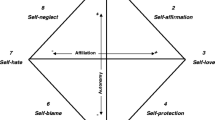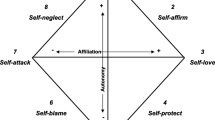Abstract
The degree to which three components of the Super Woman construct of femininity [C. Steiner-Adair (1986) “The Body Politic: Normal Female Adolescent Development and the Development of Eating Disorders” Journal of the American Academy of Psychoanalysis, Vol. 14, pp. 95–114], valuing physical appearance, striving for success in multiple roles, and insecure parental attachment, are related to eating disorder symptoms was examined for a sample of 156 college women (84% white, 6% African American, 6% Asian, 3% Latina, 1% another race). Canonical analysis yielded three significant roots, suggesting a complex relationship between components of the Super Woman model and eating disorder symptoms. The first root supports the hypothesized relationship between the three components of the Super Woman model and eating disorder symptoms. The second root suggests that striving for success, when accompanied by a context of secure parental attachment, is positively associated with measures of social competence. The third root highlights the contribution of an emphasis on physical appearance to weight concern, dieting, and bulimic behavior.
Similar content being viewed by others
References
Ainsworth, M. D. S., Blehar, M. C., Walters, E., & Wally, S. (1978).Patterns of attachment: A psychological study of the strange situation. Hillsdale, NJ: Earlbaum.
Armstrong, J. G., & Roth, D. M. (1989). Attachment and separation difficulties in eating disorders: A preliminary investigation.International Journal of Eating Disorders, 141–155.
Batgos, J. & Leadbeater, B. J. (1994). Parental attachment, peer relations, and dysphoria in adolescence. In M. Sperling & W. H. Berman (Eds).,Attachment in adults: Clinical and developmental perspectives (pp. 155–178). New York: Guilford Press.
Blos, P. (1967). The second individuation process of adolescence.Psychoanalytic Study of the Child, 72, 162–186.
Boskind-White, M., & White, W. C. (1983).Bulimarexia: The binge purge cycle. New York: Norton.
Bowlby, J. (1969).Attachment and loss: Vol. I: Attachment. New York: Basic Books.
Bowlby, J. (1973).Attachment and loss, Vol. II: Separation. New York: Basic Books.
Bowlby, J. (1988).A secure base: Parent-child attachment and healthy human development. New York: Basic.
Bruch, H. (1978).The golden cage: The enigma of anorexia nervosa. Cambridge, MA: Harvard University Press.
Cantrell, P. J., & Jon, E. B. (1991). Gender role and risk patterns for eating disorders in men and women.Journal of Clinical Psychology, 47, 53–57.
Dunn, P., & Ondercin, P. (1981). Personality variables related to compulsive eating in college women.Journal of Clinical Psychology, 37, 43–49.
Freud, A. (1969). Adolescence as a developmental disturbance. In Kaplan, G., & Lebovici, S. (Eds.),Adolescence: Psychosocial Perspectives. New York: Basic Books.
Friedlander, M., & Siegel, S. (1990). Separation-individuation difficulties and cognitive-behavioral indicators of eating disorders among college women.Journal of Counseling Psychology, 37, 74–78.
Garner, D. (1991).Eating Disorder Inventory-2. Odessa, FL: Psychological Assessment Resources.
Garner, D. M., & Olmsted, M. P. (1984).Eating Disorder Inventory. Odessa, FL: Psychological Assessment Resources.
Garner, D. M., & Olmsted, M. P., Bohr, Y., & Garfinkel, P. E. (1982). The eating attitudes test: Psychometric features and clinical correlates.Psychological Medicine, 12, 871–878.
Garner, D. M., Olmsted, M. P., & Polivy, J. (1983). Development and validation of a multidimensional eating disorder inventory for anorexia nervosa and bulimia.International Journal of Eating Disorders, 2, 15–34.
Gilligan, C. (1982).In a different voice. Cambridge, MA: Harvard University Press.
Glasnapp & Poggio. (1985).Essentials of statistical analysis for the behavioral sciences. Columbus, OH: Merril.
Gordon, R. A. (1990).Anorexia and bulimia: Anatomy of a social epidemic. Cambridge, MA: Basil Blackwell.
Hatsukami, D., Owen, P., Pyle, R., & Mitchell, J. (1982). Similarities and differences on the MMPI between women with bulimia and alcohol or drug abuse problems.Addictive Behaviors, 7, 435–439.
Heesacker, R. S., & Neimeyer, G. J. (1990). Assessing object relations and social cognitive correlate of eating disorders.Journal of Counseling Psychology, 37, 419–426.
Hesse-Biber, S. (1989). Eating patterns and disorders in a college population: Are college woman’s eating problems a new phenomenon?Sex Roles, 20, 71–89.
Hollingshead, A. B. (1957).Two factor index of social position. Unpublished manuscript, Yale Station. New Haven, CT.
Holmbeck, G. N., & Wandrei, M. L. (1993). Individual and relational predictors of adjustment in first-year college students.Journal of Counseling Psychology, 40, 73–78.
Hsu, G. L. K. (1990).Eating disorders. New York: The Guilford Press.
Kaplan, A. G., & Klein, R. (1985). The relational self in late adolescent women.Works in Progress. (Rep. No. 17). Wellesley, MA: Wellesley College, Stone Center for Developmental Services and Studies.
Katsman, M. A., & Wolchik, S. A. (1984). Bulimia and binge eating in college women: A comparison of personality and behavioral characteristics.Journal of Consulting and Clinical Psychology, 52, 423–428.
Kenny, M. (1987). The extent and function of parental attachment among first-year college students.Journal of Youth and Adolescence, 16, 17–27.
Kenny, M. E. (1990). College seniors’ perceptions of parental attachments: The value and stability of family ties.Journal of College Student Development, 31, 39–46.
Kenny, M., & Donaldson, G. (1991). Contributions of parental attachment and family structure to the social and psychological functioning of first year college students.Journal of Counseling Psychology, 38, 479–486.
Kenny, M., & Hart, K. (1992). Relationship between parental attachment and eating disorders in an inpatient and a college sample.Journal of Counseling Psychology, 39, 521–526.
Klemchuck, H. P., Hutchinson, C. P., & Frank, R. I. (1990). Body dissatisfaction and eating-related problems on the college campus: Usefulness of the Eating Disorders Inventory with a nonclinical population.Journal of Counseling Psychology, 37, 297–305.
Lapsley, D. K., Rice, K. G., & FitzGerald, D. (1990). Adolescent attachment, identity, and adjustment to college: Implications for the continuity of adaptation hypothesis.Journal of Counseling and Development, 68, 561–565.
Lewis, L. D., & Johnson, C. (1985). A comparison of sex role orientation between women with bulimia and normal controls.International Journal of Eating Disorders, 4, 247–257.
Lewinsohn, P. M., & Rosenbaum, M. (1987). Recall of parental behavior by acute depressives, remitted depressives, and nondepressives.Journal of Personality and Social Psychology, 52, 611–619.
Linville, P. W. (1985). Self-complexity and affective extremity: Don’t put all of your eggs in one cognitive basket.Social Cognition, 3, 94–120.
Miller, J. B. (1976).Toward a new psychology of women. Boston: Beacon Press.
Mintz, L. B., & Betz, N. E. (1988). Prevalence and correlates of eating disordered behaviors among undergraduate women.Journal of Counseling Psychology, 35, 463–471.
Minuchin, S., Rosman, B. L., & Baker, L. (1978).Psychosomatic families: Anorexia nervosa in context. Cambridge, MA: Harvard University Press.
Moos, R. (1985).Family environment scale manual. Palo Alto, CA: Consulting Psychologists Press.
Murnen, S. K., Smolak, L., & Levine, M. P. (1994).Development of a scale to measure adherence to the “Superwoman” construct. Unpublished manuscript, Kenyon College.
Norman D. K., & Herzog, D. B. (1983). Bulimia, anorexia nervosa and anorexia nervosa with bulimia.International Journal of Eating Disorders, 2, 43–52.
Orleans, C. T., & Barnett, L. R. (1984). Bulimarexia: Guidelines for behavioral assessment and Treatment. In R. C. Hawkins, W. J. Fremouw, & P. F. Clement (Eds.),The Binge-Purge Syndrome (pp. 144–182). New York: Springer.
Raciti, M. C., & Norcross, J. C. (1987). The EAT and EDI: Screening, interrelationship and psychometrics.International Journal of Eating Disorders, 6, 579–586.
Spence, J. T., & Helmreich, R. L. (1978).Masculinity and Femininity: Their psychological dimensions, correlates, and antecedents. Austin: University of Texas Press.
Steiner-Adair, C. (1986). The body politic: Normal female adolescent development and the development of eating disorders.Journal of The American Academy of Psychoanalysis, 14, 95–114.
Steiner-Adair, C. (1989). Developing the voice of the wise women: College students and bulimia.Journal of College Student Psychotherapy, 3, 151–165.
Striegel-Moore, R. H., McAvay, G., & Rodin, J. (1986). Psychological and behavioral correlates of feeling fat in women.International Journal of Eating Disorders, 5, 935–947.
Striegel-Moore, R. H., Silberstein, L. R., & Rodin, J. (1986). Toward an understanding of risk factors for bulimia.American Psychologist, 42, 247–263.
Surrey, J. L. (1984). Eating patterns as a reflection of women’s development. InWorks in progress. (Rep. No. 9). Wellesley, MA: Wellesley College, Stone Center for Developmental Services and Studies.
Tabachnick, B. G., & Fidell, L. S. (1989).Using multivariate statistics. New York: Harper & Row.
Thorton, B., Leo, R., & Alberg, K. (1991). Gender role typing and the superwoman ideal, and the potential for eating disorders.Sex Roles, 25, 469–484.
Timko, C., Striegel-Moore, R. H., Silberstein, L. R, & Rodin, J. (1987). Femininity/ masculinity and disordered eating in women: How are they related?International Journal of Eating Disorders, 6, 701–712.
Van Thorpe, M., & Vogel, F. (1985). The presence of bulimia in high school females.Adolescence, 20, 45–51.
Williamson, D. A., Kelley, M. L., Davis, C. T., Ruggiero, L., & Blouin, D. C. (1985). Psychopathology of eating disorders: A controlled comparison of bulimic, obese, and normal subjects.Journal of Consulting and Clinical Psychology, 53, 161–263.
Author information
Authors and Affiliations
Additional information
This article is based upon a dissertation completed at Boston College by the first author, under the supervision of the second author. We gratefully acknowledge the comments of James Mahalik on a previous draft of this manuscript.
Rights and permissions
About this article
Cite this article
Hart, K., Kenny, M.E. Adherence to the Super Woman ideal and eating disorder symptoms among college women. Sex Roles 36, 461–478 (1997). https://doi.org/10.1007/BF02766684
Issue Date:
DOI: https://doi.org/10.1007/BF02766684




